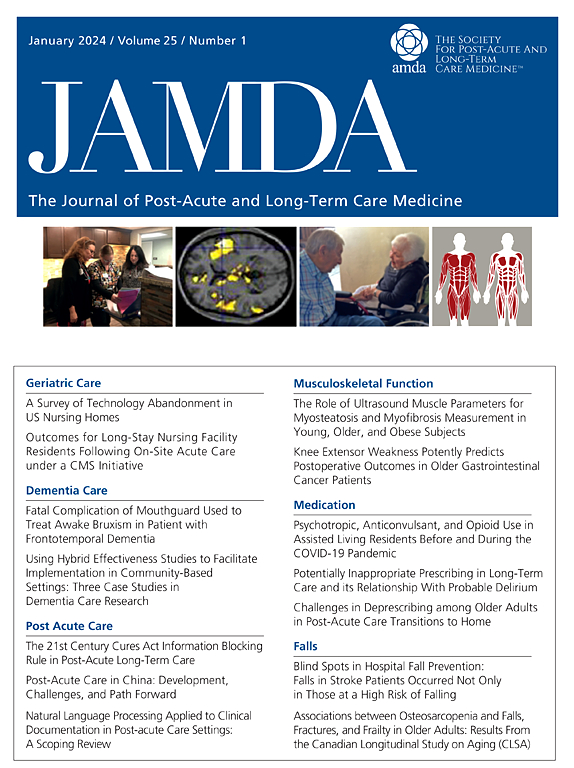社会活动对社区居住老年慢性疼痛患者残疾发生率的保护作用
IF 4.2
2区 医学
Q2 GERIATRICS & GERONTOLOGY
Journal of the American Medical Directors Association
Pub Date : 2025-05-12
DOI:10.1016/j.jamda.2025.105623
引用次数: 0
摘要
目的确定导致老年人残疾发生率的因素以及可参与的减少残疾风险的活动对老年人的健康至关重要。本研究旨在评估社会活动对老年慢性疼痛患者随访检查中残疾发生率的影响。设计前瞻性队列研究。背景和参与者本研究纳入4692名基线时无残疾的社区居住老年人(年龄73.8±5.5岁,男性:n = 2043)。方法在基线时评估慢性疼痛和社交活动数据,并在基线后24个月的随访检查中调查残疾发生率。结果共有1587名(33.8%)参与者在基线时报告慢性疼痛,206名(4.4%)参与者在随访检查时报告残疾。Cox比例风险模型显示,慢性疼痛组残疾发生率的风险比(HR)高于无慢性疼痛组[HR, 1.77;95%置信区间(CI), 1.33-2.35;P & lt;措施)。与低社交活动相比,高社交活动显著预防慢性疼痛组残疾的发生(HR, 0.57;95% ci, 0.39-0.84;P = .005)。事件参与对慢性疼痛组残疾发生率有保护作用(HR, 0.60;95% ci, 0.40-0.91;P = .02)。结论和意义本研究表明,基线慢性疼痛会增加发展为残疾的风险,而与低社交活动相比,高社交活动可以降低这一风险。这些结果表明,社会活动对社区居住的慢性疼痛老年人残疾发生率的重要作用。本文章由计算机程序翻译,如有差异,请以英文原文为准。
Protective Effects of Social Activity on the Disability Incidence among Community-Dwelling Older Adults with Chronic Pain
Objectives
Identifying the factors that contribute to the incidence of disability in older adults and the activities that can be engaged in to reduce the risk of disability is critical to the health of older adults. This study aimed to assess the impact of social activities on the incidence of disability during follow-up examinations in older adults with chronic pain.
Design
A prospective cohort study.
Settings and Participants
The study included 4692 community-dwelling older adults (aged 73.8 ± 5.5 years, male: n = 2043) without disability at baseline.
Methods
Chronic pain and social activity data were assessed at baseline and the incidence of disability was investigated during the follow-up examination after 24 months from baseline.
Results
In total, 1587 (33.8%) participants reported chronic pain at baseline, and 206 (4.4%) reported disability at follow-up examination. The Cox proportional hazards model showed that the chronic pain group had a higher hazard ratio (HR) for disability incidence compared with the group without chronic pain [HR, 1.77; 95% confidence interval (CI), 1.33–2.35; P < .001]. High social activity significantly prevented the incidence of disability compared with low social activity in the chronic pain group (HR, 0.57; 95% CI, 0.39–0.84; P = .005). Event participation had a protective effect on disability incidence in the chronic pain group (HR, 0.60; 95% CI, 0.40–0.91; P = .02).
Conclusion and Implications
This study shows that chronic pain at baseline increases the risk of developing disability, whereas high social activity reduces that risk compared with low social activities. These results suggest the important role of social activities regarding the incidence of disability in community-dwelling older adults with chronic pain.
求助全文
通过发布文献求助,成功后即可免费获取论文全文。
去求助
来源期刊
CiteScore
11.10
自引率
6.60%
发文量
472
审稿时长
44 days
期刊介绍:
JAMDA, the official journal of AMDA - The Society for Post-Acute and Long-Term Care Medicine, is a leading peer-reviewed publication that offers practical information and research geared towards healthcare professionals in the post-acute and long-term care fields. It is also a valuable resource for policy-makers, organizational leaders, educators, and advocates.
The journal provides essential information for various healthcare professionals such as medical directors, attending physicians, nurses, consultant pharmacists, geriatric psychiatrists, nurse practitioners, physician assistants, physical and occupational therapists, social workers, and others involved in providing, overseeing, and promoting quality

 求助内容:
求助内容: 应助结果提醒方式:
应助结果提醒方式:


